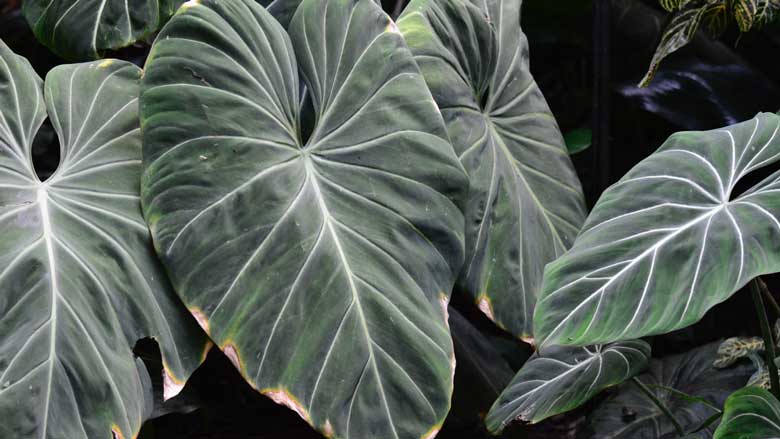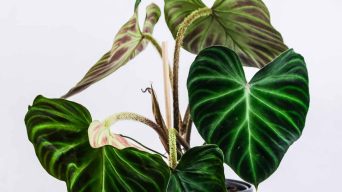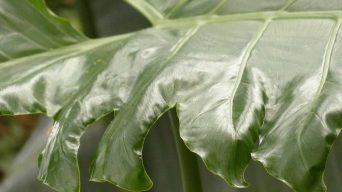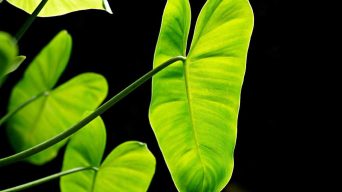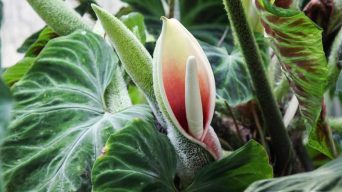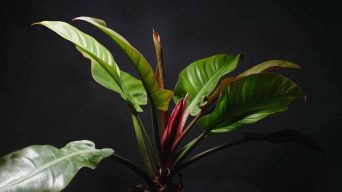Brown spots on philodendron leaves can result from sunburn, overwatering, low humidity, fertilizer imbalance, nutrient deficiencies, pests, or diseases like bacterial or fungal leaf spots. Treatment involves identifying and addressing the specific cause, such as adjusting light, water, humidity, or nutrient levels and using appropriate treatments for pests and diseases.
Philodendron plants are easy to care for, but a common issue they face is the appearance of brown spots on their leaves.
These spots can arise from various factors, such as excessive sunlight, overwatering, or pest infestation.
To effectively treat these brown spots, it’s crucial first to identify the underlying cause. This allows for a targeted approach to treatment.
Below are the primary causes of brown spots on philodendron leaves and the corresponding solutions.
Understanding and Addressing Brown Spots on Philodendron Leaves
Philodendrons are tropical plants that are native to South America.
The Philodendron Birkin, Philodendron Brasil, and Philodendron hederaceum are some of the most popular species.
These plants are known for their beautiful, glossy green leaves.
However, sometimes Philodendron leaves can develop brown spots. There are a few different reasons why this may happen.
The most common causes are listed below.
1. Sunburn
Sunburn is a common problem for philodendrons, as they are native to tropical regions and require bright indirect light.
When leaves are exposed to too much sunlight, they can develop brown spots.
This is called sunburn, a type of leaf damage that can occur when plants are not properly protected from the sun.
The symptoms of sunburn are typically seen on the plant leaves, but the stem and flowers can also be affected.
Sunburn usually appears as small, dark brown patches on the leaves of philodendrons.
These spots are caused by the exposure of the leaves to ultraviolet (UV) rays from the sun.
The UV rays cause the plant cells to break down, leading to brown spots on the leaves.
A sunburned philodendron can be prevented by providing proper protection from the sun, such as shading them with a physical barrier or using a sunscreen specifically designed for plants.
Treatment Strategies for Sunburn
If your philodendron plant has developed brown spots due to sunburn, moving it to a location that receives less direct sunlight is best.
Philodendrons need bright indirect light to thrive, so a spot that receives dappled sunlight or filtered light would be ideal.
You can also protect it from the sun by shading your plant with a physical barrier such as a curtain or umbrella.
If the spots are small and lightly colored, they will usually fade within a few weeks.
However, if the spots are large or dark, they may be permanent and will not fade.
In this case, you can try to remove the spots by carefully trimming off the affected leaves with a sharp knife or pair of scissors.
2. Watering Issues
Brown spots on philodendron plants can be caused by several watering problems.
When overwatered, the leaves may turn brown and rot. This occurs because the plant struggles to expel the excess water, essentially suffocating.
Additionally, overwatering can promote fungal growth, another culprit for brown spots.
Conversely, under-watering leads to brown, dropping leaves due to insufficient moisture absorption, resulting in dehydration.
The water quality used for houseplants also plays a role. Water too hard or high in mineral content can leave deposits on leaves, causing brown spots.
Remedying Watering Problems
If you think your plant’s brown spots are due to a watering issue, the best action is to adjust your watering schedule.
Philodendrons need to be watered every one to two weeks, depending on the size of the plant and the amount of light it receives.
The soil should be moist but not soggy, and you should allow the top inch of soil to dry out between waterings.
If you use hard water or water with high mineral content, you can try watering your plant with distilled water or rainwater.
3. Inadequate Humidity
Low humidity is a key environmental factor leading to brown spots on philodendrons.
Native to tropical rainforests, philodendrons thrive in high humidity. In contrast, drier conditions often lead to dehydration, manifesting as brown and crispy leaves.
The impact of low humidity on philodendrons is multifaceted:
- Dry air accelerates leaf moisture loss, leading to dehydration and subsequent browning.
- A low-humidity environment is conducive to fungal growth, which can cause brown spots.
- Dry conditions can weaken the cell walls of the leaves, making them brittle and more prone to browning.
These combined effects contribute to the browning of philodendron leaves, detracting from their aesthetic appeal.
Solutions for Low Humidity
If you think your plant’s brown spots are due to low humidity, the best course of action is to increase the humidity around your plant.
This can be done in several ways, such as using a humidifier, grouping plants together, or placing the pot on a pebble tray.
You can also try misting your plant with water, but do this in the morning so the leaves have time to dry before nightfall.
4. Fertilizer Imbalance
Fertilization burn is a type of leaf damage that can occur when plants are over-fertilized.
The symptoms of fertilization burn are typically seen on the leaves of plants, but the stem and flowers can also be affected.
Fertilization burn usually appear as small, dark brown spots on the leaves of plants. These spots are caused by the exposure of the leaves to too much fertilizer.
The fertilizer causes the plant cells to break down, leaving brown spots on the leaves.
On the other hand, if the plant is not fertilized frequently enough, the leaves will turn yellow and eventually brown.
This is because the plant cannot get the nutrients it needs from the soil, and it begins to starve.
The type of fertilizer that is used can also cause brown spots on the leaves.
If the fertilizer is too high in nitrogen, it can burn the leaves, causing brown spots.
Likewise, an excessive phosphorus content in the fertilizer can lead to leaf discoloration, turning them yellow and brown.
Correcting Fertilization Issues
Adjusting your fertilization schedule is best if your plant’s brown spots are due to a fertilizer issue.
Philodendrons must be fertilized every one to two weeks during the growing season.
Use a balanced fertilizer that is low in nitrogen and phosphorus.
If you are unsure how much fertilizer to use, always err on using less rather than more.
It is also essential to make sure that you apply the fertilizer to moist soil.
This will help prevent the fertilizer from burning the plant’s roots.
5. Nutrient Deficiencies
Philodendrons, originating from tropical rainforests, thrive in nutrient-rich soils.
However, when grown in less fertile environments, they may develop nutrient deficiencies, commonly in calcium, magnesium, and boron.
These deficiencies, often due to poor soil quality, inadequate fertilization, or insufficient watering, manifest as brown, crispy spots on the leaves.
Insufficient nutrient intake from the soil leads to visible stress signs in the plant, including these brown spots.
Addressing Nutrient Shortages
If you think your plant’s brown spots are due to a nutrient deficiency, the best action is to fertilize your plant with a balanced fertilizer.
You can also add some compost or organic matter to the soil to improve its quality.
Ensure that you water your plant regularly and thoroughly, as this will help the plant absorb the nutrients it needs from the soil.
If you suspect that your plant is suffering from a calcium deficiency, you can try spraying the leaves with a calcium-rich solution.
You can make this solution by dissolving one tablespoon of lime in one gallon of water.
Spray the leaves with this solution once a week until the spots disappear.
Epsom salt is often recommended as a treatment for magnesium deficiencies.
You can make a magnesium sulfate solution by dissolving one tablespoon of Epsom salt in one gallon of water.
Spray the leaves with this solution once a week until the deficiency is corrected.
For boron deficiencies, you can try spraying the leaves with a solution of 1/2 tablespoon of boric acid in one gallon of water.
Spray the leaves with this solution once every two weeks until the deficiency is corrected.
6. Pest Infestations
Pest infestations are a common cause of brown spots on philodendrons. These indoor plants frequently fall prey to various pests such as aphids, spider mites, scale insects, and mealybugs, all of which feed on plant sap and can cause significant leaf damage.
Aphids, small and soft-bodied, typically inhabit the undersides of leaves. Their sap-sucking activity often results in yellowing and browning of foliage.
Similarly, spider mites, tiny arachnid-like creatures, also prefer the leaf undersides. They extract sap and leave fine webbing on the leaves, leading to yellow and brown discoloration.
Scale insects are another threat. They adhere to leaves, sapping nutrients and causing brown spots. Mealybugs, small and white, usually cluster on stems and leaves. Like the others, their feeding damages the leaves, manifesting as browning.
Regular inspection and prompt action are crucial to prevent these pests from harming your philodendrons.
Effective Pest Control Methods
If you think that a pest infestation causes your plant’s brown spots, the best course of action is to treat the infestation as soon as possible.
Various products can be used to treat pest infestations, including insecticidal soap, neem oil, and horticultural oil.
These products will kill the pests causing the problem without harming the plant.
To treat an infestation, spray the infected plant with water to remove any dust or debris on the leaves.
This will help the treatment to penetrate the philodendron leaves and reach the pests.
Next, apply the insecticide, oil, or soap according to the manufacturer’s instructions.
Be sure to cover all of the affected areas of the plant and reapply the treatment every 7-10 days until the pests are gone.
7. Common Diseases Leading to Brown Spots
Philodendrons are often affected by certain diseases that result in brown spots on their leaves.
The most prevalent are bacterial leaf spots, fungal leaf spots, and anthracnose.
a. Bacterial Leaf Spot
Bacterial Leaf Spot is a type of disease caused by several different bacteria.
These bacteria enter the plant through wounds in the leaves and cause damage. The bacterial leaf spot disease symptoms include small, dark brown spots on the leaves.
A yellow halo often surrounds the spots.
This disease is most commonly seen in philodendrons grown in wet, humid conditions.
b. Fungal Leaf Spot
Fungal Leaf Spot is another type of disease that can affect philodendrons.
Several fungi cause this disease, often affecting plants grown in wet, humid conditions.
The disease symptoms include small brown spots on the leaves, which can eventually turn into large, dark patches.
A yellow halo often surrounds the spots, and they may eventually cause the philodendron leaves to drop off the plant.
c. Anthracnose
Anthracnose is a common fungal disease affecting many plant types, including philodendrons.
This condition exhibits brown or black leaf spots, potentially resulting in the yellowing and shedding of philodendron leaves.
The fungus that causes anthracnose thrives in wet, humid conditions, so it is essential to keep your philodendron dry if you live in an area with high humidity.
Disease Management Techniques
If you believe your philodendron has any of the diseases mentioned above, it is essential to take action immediately.
These diseases can spread quickly and kill your plant if left untreated.
The first step in treating these diseases is removing infected leaves from the plant.
This will help to stop the disease from spreading.
Once you have removed the infected leaves, you should dispose of them in a garbage bag so they cannot spread the disease to other plants.
After removing the infected leaves, you should treat the plant with a fungicide or bactericide.
There are several different products available, and you should select one specifically designed to treat the type of disease your plant has.
It is essential to carefully follow the instructions on the product label, as using too much of the treatment can damage your plant.
Once you have treated your plant, you should monitor it closely to ensure the disease does not return.
Prevention Strategies for Brown Spots on Philodendron Plants
Maintaining a healthy and stress-free philodendron is key to preventing brown spots on its leaves.
Here’s how to ensure your plant thrives:
- Lighting: Position your philodendron in an area with bright, indirect sunlight. While these plants can survive in low light, browning leaves indicate insufficient light.
- Watering: Water the plant when the top inch of soil feels dry. Avoid overwatering, as it’s a common cause of brown spots. Let the soil dry slightly between waterings.
- Potting Mix: Opt for a well-draining mix. Philodendrons prefer moist (but not wet) roots and a good potting mix can prevent root rot, a culprit for brown leaf spots.
- Fertilization: During the growing season, feed your philodendron monthly with a balanced fertilizer to maintain its health.
- Temperature: As tropical plants, philodendrons favor warm environments. Protect them from drafts and cold windows, especially in winter.
- Humidity: These plants need high humidity. Regularly mist the leaves or place the plant on a pebble tray filled with water to increase moisture around it.
- Pruning: Regularly prune the philodendron. Remove dead or dying leaves, and trim any that begin to show brown spots. This not only prevents spreading but also encourages healthier growth.
These plant care tips can effectively prevent brown spots and keep your philodendron plant vibrant and healthy.
Final Thoughts
Caring for philodendron plants is generally straightforward. However, they are not immune to occasional issues.
One common problem is brown spots on the leaves, often stemming from excessive sunlight or improper watering.
By adhering to the guidelines outlined in this article, you can effectively prevent these spots, ensuring your philodendron remains healthy and vibrant.

